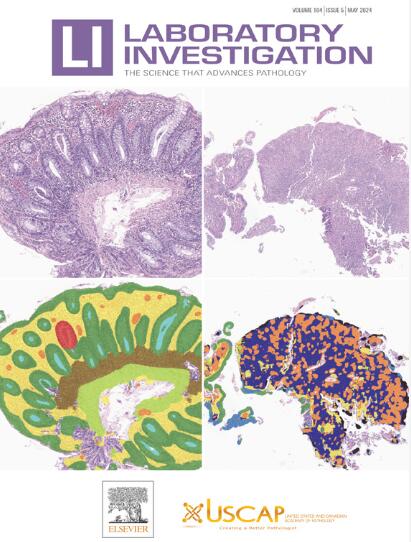Spatial Correlation of the Extracellular Matrix to Immune Cell Phenotypes in the Tumor Boundary of Clear Cell Renal Cell Carcinoma Revealed by Cyclic Immunohistochemistry
IF 5.1
2区 医学
Q1 MEDICINE, RESEARCH & EXPERIMENTAL
引用次数: 0
Abstract
The significance of the tumor microenvironment (TME) in predicting immunotherapy efficacy is increasingly acknowledged. However, the complexity of the TME necessitates novel technological approaches for the precise characterization of individual cell types, functional phenotypes, and heterocellular spatial interactions. This study utilizes a streamlined multiplex cyclic immunohistochemistry (cycIHC) protocol for detailed TME annotation. Unlike proprietary methods, cycIHC relies on iterative cycles of conventional immunohistochemistry, using off-the-shelf antibodies and reagents, followed by digitalization, chromogen removal, and antibody stripping. The method was combined with open-source tools for the coregistration of individual staining cycles. Using clear cell renal cell carcinoma (ccRCC) as a model, the protocol was applied for granular annotation of cellular and acellular structures in the tumor boundary zone. Our results demonstrate that the tumor periphery, particularly the pseudocapsule of ccRCC, is homogeneously organized across the 3D scale, yet exhibits distinct cellular distribution gradients of T and B cells. These patterns correspond to deposited extracellular matrix proteins, especially collagen types I and VI. Our findings indicate an instructive impact of extracellular matrix proteins on defining the spatial organization of immune cells in the TME of ccRCC. The developed cycIHC method facilitates detailed characterization of the TME and may enhance the understanding of tumor-immune cell interactions.
循环免疫组织化学揭示ccRCC肿瘤边界细胞外基质与免疫细胞表型的空间相关性
肿瘤微环境(TME)在预测免疫疗法疗效方面的重要性日益得到认可。然而,由于肿瘤微环境的复杂性,需要采用新的技术方法来精确表征单个细胞类型、功能表型和异细胞空间相互作用。本研究采用了简化的多重循环免疫组化(cycIHC)方案来详细标注TME。与专有方法不同的是,cycIHC 依赖于传统免疫组化的反复循环,使用现成的抗体和试剂,然后进行数字化、色原去除和抗体剥离。该方法与开源工具相结合,可对单个染色周期进行联合注册。以透明细胞肾细胞癌(ccRCC)为模型,应用该方案对肿瘤边界区的细胞和无细胞结构进行颗粒注释。我们的研究结果表明,肿瘤外围,尤其是ccRCC的假包囊,在三维尺度上组织均匀,但却表现出明显的T细胞和B细胞分布梯度。这些模式与沉积的细胞外基质蛋白,尤其是 I 型和 VI 型胶原蛋白相对应。我们的研究结果表明,细胞外基质(ECM)蛋白对确定ccRCC TME中免疫细胞的空间组织具有指导意义。所开发的 cycIHC 方法有助于详细描述 TME 的特征,并可加深对肿瘤-免疫细胞相互作用的理解。
本文章由计算机程序翻译,如有差异,请以英文原文为准。
求助全文
约1分钟内获得全文
求助全文
来源期刊

Laboratory Investigation
医学-病理学
CiteScore
8.30
自引率
0.00%
发文量
125
审稿时长
2 months
期刊介绍:
Laboratory Investigation is an international journal owned by the United States and Canadian Academy of Pathology. Laboratory Investigation offers prompt publication of high-quality original research in all biomedical disciplines relating to the understanding of human disease and the application of new methods to the diagnosis of disease. Both human and experimental studies are welcome.
 求助内容:
求助内容: 应助结果提醒方式:
应助结果提醒方式:


